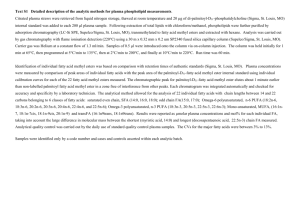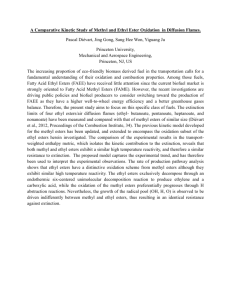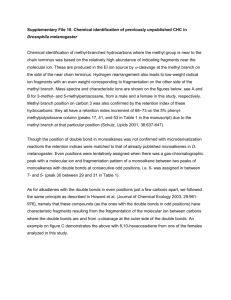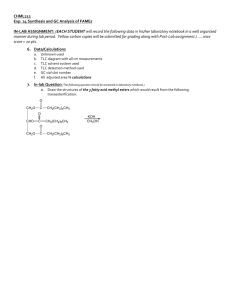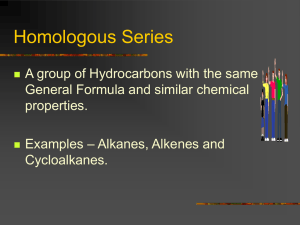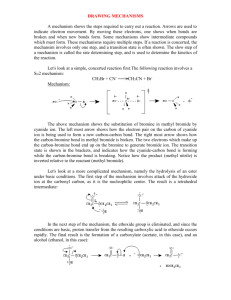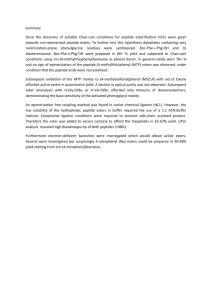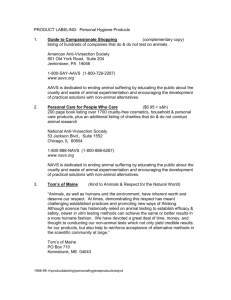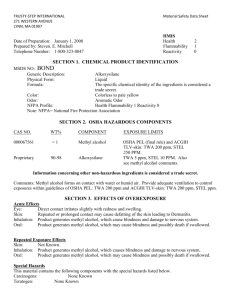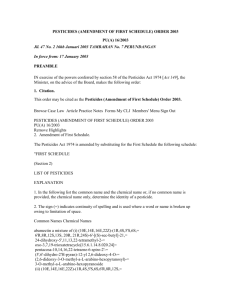SUPPLEMEMTARY MATERIAL Solvent free hydroxylation of the
advertisement
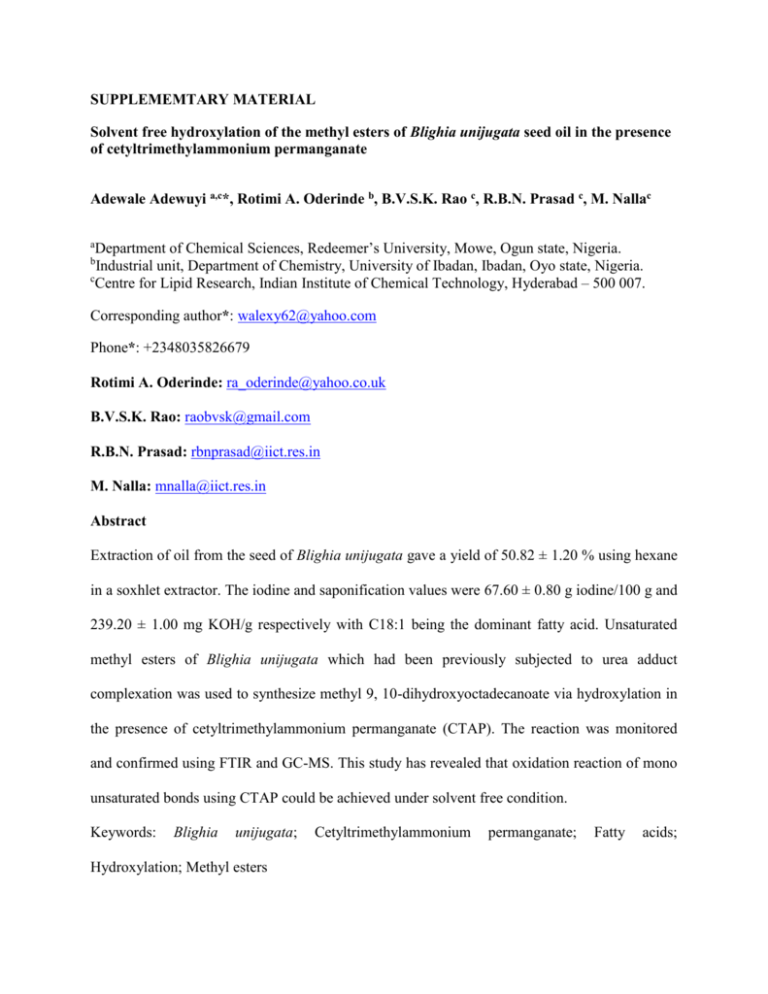
SUPPLEMEMTARY MATERIAL Solvent free hydroxylation of the methyl esters of Blighia unijugata seed oil in the presence of cetyltrimethylammonium permanganate Adewale Adewuyi a,c*, Rotimi A. Oderinde b, B.V.S.K. Rao c, R.B.N. Prasad c, M. Nallac Department of Chemical Sciences, Redeemer’s University, Mowe, Ogun state, Nigeria. Industrial unit, Department of Chemistry, University of Ibadan, Ibadan, Oyo state, Nigeria. c Centre for Lipid Research, Indian Institute of Chemical Technology, Hyderabad – 500 007. a b Corresponding author*: walexy62@yahoo.com Phone*: +2348035826679 Rotimi A. Oderinde: ra_oderinde@yahoo.co.uk B.V.S.K. Rao: raobvsk@gmail.com R.B.N. Prasad: rbnprasad@iict.res.in M. Nalla: mnalla@iict.res.in Abstract Extraction of oil from the seed of Blighia unijugata gave a yield of 50.82 ± 1.20 % using hexane in a soxhlet extractor. The iodine and saponification values were 67.60 ± 0.80 g iodine/100 g and 239.20 ± 1.00 mg KOH/g respectively with C18:1 being the dominant fatty acid. Unsaturated methyl esters of Blighia unijugata which had been previously subjected to urea adduct complexation was used to synthesize methyl 9, 10-dihydroxyoctadecanoate via hydroxylation in the presence of cetyltrimethylammonium permanganate (CTAP). The reaction was monitored and confirmed using FTIR and GC-MS. This study has revealed that oxidation reaction of mono unsaturated bonds using CTAP could be achieved under solvent free condition. Keywords: Blighia unijugata; Hydroxylation; Methyl esters Cetyltrimethylammonium permanganate; Fatty acids; Materials and method Extraction and chemical analysis of the seed oil of Blighia unijugata The dried seeds of Blighia unijugata were extracted with n-hexane for 10 hr using soxhlet extractor (Adewuyi et al. 2009). The oil was analyzed for iodine, saponification and free fatty acid content by method described by the Association of Official Analytical Chemist (AOAC, 1994). Fatty acid composition of Blighia unijugata Fatty acid methyl esters of the oil were prepared by refluxing the sample at 70 oC for 3 h in 2% sulphuric acid in methanol. The esters were extracted into ethyl acetate, washed free of acid and passed over anhydrous sodium sulphate. The ethyl acetate extracts were further concentrated using a rotary evaporator. The fatty acid composition was analyzed using an Agilent 6890 N series gas chromatography equipped with FID detector on a split injector. A fused silica capillary column (DB-225, 30 x 0.32 m i.d., J & W Scientifics, USA) was used with the injector and detector temperature maintained at 230oC and 250oC respectively. The oven temperature was programmed at 160oC for 2 min and finally increased to 230oC at 4oC/min. The carrier gas was nitrogen at a flow rate of 1.5 mL/min. The area percentages were recorded with a standard Chemstation Data System. Urea adduct complexation reaction of Blighia unijugata methyl esters Methyl esters (100 g) were dissolved in methanol (1000 ml) to which urea (200 g) had been added. The mixture was warmed with stirring until the whole mixture turned into a clear homogeneous solution (Christie, 1982). The solution was allowed to cool to room temperature and kept refrigerated at 5oC for 8 h. Crystals were removed by filtering through a Buchner funnel to remove the urea complexes, which were washed twice with 25 ml of methanol saturated with urea. The filtrate which is rich in unsaturated methyl esters was poured into 1% hydrochloric acid (600ml) and extracted alternatively with hexane and diethyl ether. The combined organic layers were washed with water twice (50 ml) and passed over anhydrous sodium sulphate and later concentrated using a rotary evaporator. This reaction was repeated changing the ratio of fatty acid methyl esters to urea from 1:2 to 2:1 in order to further increase the unsaturation of the methyl esters. The resulting methyl esters (BME) were then taken for the determination of the constituent fatty acids using a GC as described above. Preparation of cetyltrimethylammonium permanganate This was achieved by introducing a solution of 27.0 mmol of KMnO4 (4.25 g in 25 ml distilled water) into a 250 ml two-necked round bottom flask in a water bath maintained at 8oC. After about 15 min, solution of 25.0 mmol of cetyltrimethylammonium bromide (9.10 g in 50 ml dichloromethane) was added into the flask and stirred for 4h. The organic layer was separated and the solvent recovered under reduced pressure with the crystalline cetyltrimethylammonium permanganate (purple coloured) precipitating out before the complete recovery of the solvent; it was filtered, washed with distilled water and ether and dried over P2O5 under vacuum. Dihydroxylation of BME using cetyltrimethylammonium permanganate The dihydroxylation was carried out in a clamped three necked round bottom flask equipped with a thermometer and a stirrer in a thermo-regulated water bath. About 2.10 g (5.2 mmol) of cetyltrimethylammonium permanganate with five drops of distilled water was introduced into the flask. About 5.0 mmol of BME was slowly added drop wise while stirring the mixture. The mixture was stirred for 1h and extracted three times with 50 ml portion of ether; this was later washed with saturated solution of NaCl, dried over Na2SO4 and concentrated on a rotary evaporator. Isolation of methyl 9, 10-dihydroxyoctadecanoate The final product was separated on a 1 g scale by silica gel column chromatography using a glass column 20 cm x 2 cm OD packed with 30 g activated silica gel (60–120 mesh). Hydrocarbons and other non-polar compounds were eluted with petroleum ether (boiling point, 60-80oC). The methyl 9, 10-dihydroxyoctadecanoate were eluted using a mixture of petroleum ether - diethyl ether (40:60 v/v). The fractions were screened by TLC for the identification of the compounds isolated. The eluted spots were identified using iodine vapors. Trimethylsilylation derivatisation and GC-MS analysis of methyl 9, 10dihydroxyoctadecanoate The isolated methyl 9,10-dihydroxyoctadecanoate was derivatised and identified by GC-MS analysis using Agilent (Palo Alto, USA) 6890N gas chromatography equipped with an HP-1 MS capillary column connected to an Agilent 5973 mass spectrometer operating in the EI mode (70 ev; m/z 50-550; source temperature 230oC and quadruple temperature 150oC). Methyl 9,10dihydroxyoctadecanoate was silylated using N,O-Bis(trimethylsilyl)trifluoroacetamide; about 13 µl/mg of N,O-Bis(trimethylsilyl)trifluoroacetamide was added to methyl 9,10- dihydroxyoctadecanoate, kept at 75oC for 60 min and thoroughly shaken. The final product was extracted in ethyl acetate and concentrated using a rotary evaporator. Structural assignments were made based on interpretation of mass spectrometric fragmentation and confirmation by comparison of retention time as well as fragmentation pattern of authentic compounds and the spectral data obtained from the Wiley and NIST libraries. Fourier Transform Infrared (FTIR) The FTIR spectra of the methyl esters and hydroxylated methyl esters were recorded using a Perkin Elmer FTIR system spectrum BX LR64912C. The samples were spread over NaCl cells, and their spectra were recorded in the range of 4000-400 cm-1. Reference Adewuyi A, Oderinde RA, Ajayi IA (2009) The Metal Composition, Proximate Properties and the Effect of Refining on the Physico-Chemical Characterization of Baphia nitida and Gliricidia sepium. Seed and Seed Oil J Food Technol. 7: 43-49 AOAC (1994) Official Methods of Analysis, 14 ed, Vol.67. Association of Official Analytical Chemist, Arlington, VA Burkill HM (2000) The useful plants of West Tropical Africa. Royal botanical garden, 2nd ed, vol 5, pp 11-13 Christie WW (1982) Lipid analysis, 2nd edn Pergamoon press, pp 107-130 Gamez MN, Noriega RJA, Medina JLA, Ortega GJ, Monroy RJ, Toro VFJ, Garcia HS, Angulo O (2003) Concentration of EPA and DHA from fish oil by hydrolysis and urea complexation. Food Res Int 36: 721–727 Gervasio GC (1996) In: Hui, Y.H. (Ed.), Fatty Acids and Derivatives from Coconut Oil in Bailey’s Industrial Oil and Fat Products vol. 5, 5th edn John Wiley and Sons, NY, pp 33–83 Hu YH, Gao Y, Wang DN, Hu CP, Zhu S, Vanoverloop L, Randall D (2002) Rigid polyurethane foam prepared from a rape seed oil based polyol. J Appl Polym Sci 84: 591 Khot SN, Lascala JJ, Can E, Morye SS, Williams GI, Palmese GR, Kusefoglu SH, Wool RP (2001) Development and application of triglyceride-based polymers and composites. J Appl Polym Sci 82: 703–723 Kidwai M, Poonam M (2005) Neat reaction technology: A green tool. Ind J Chem 45: 2330-2336 Lucy SH, Jer HL (2001) Fractionation of urea-pretreated squid visceral oil ethyl esters. J Am Oil Chem Soc 78: 473–476 Oderinde RA, Ajayi IA, Adewuyi A (2008) Evaluation of the mineral nutrients, characterization and some possible uses of Blighia unijugata bak seed and oil. Seed Sci Biotechnol 2: 79 – 82 Schwab AW, Bagby MO, Freeman B (1987) Preparation and properties of diesel fuels from vegetable oils. Fuel 66: 1372–1378 Strocchi A, Bonaga G (1975) Correlation between urea inclution compounds and conformational structure of unsaturated C18 fatty acid methyl esters. Chem Phys Lipids 15: 87-94 Tor C, Yi H (2001) Polyunsaturated fatty acid concentrates from borage and linseed oil fatty acid. J Am Oil Chem Soc 78: 485–488 Udaya N, Wanasundara X, Shahidi F (1999) Concentration of omega 3-polyunsaturated fatty acids of seal blubber oil by urea complexation: Optimization of reaction conditions. Food Chem 65: 41–49 Welton T (2001) Ionic liquids in Green Chemistry. Green Chem 13: 225-225
